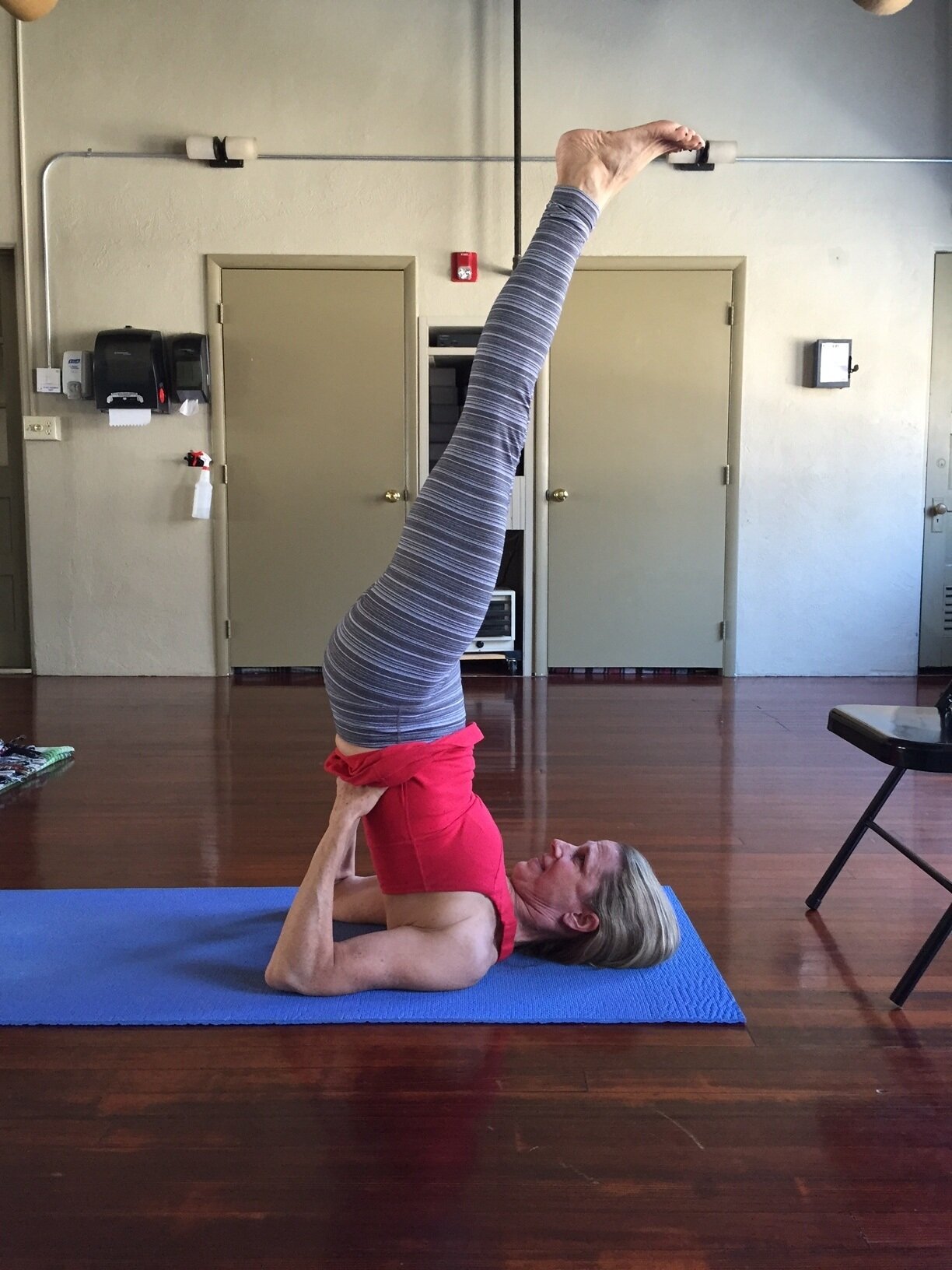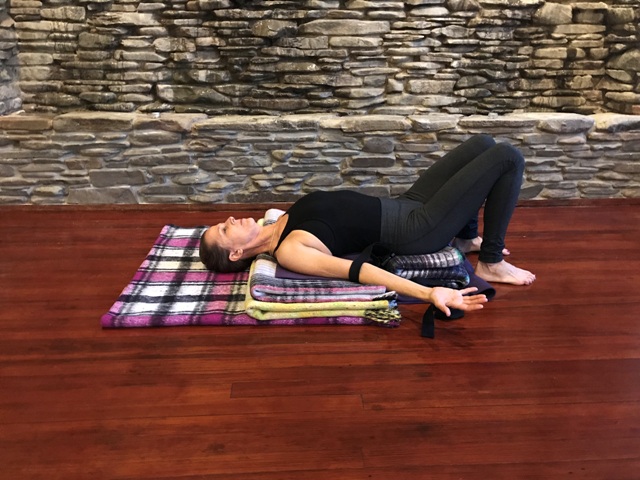Sure, yoga can make us stronger and more flexible, but the postures can do so much more for us if we know how to use them. Each group of poses has a different energy and each pose within that group evokes that energy in very specific ways. Knowing how to work with the energy of the poses can help you with such things as overcoming jet lag.
Conventional wisdom suggests that for each time zone you cross, it takes one day to adjust. So, traveling can leave you unable to fall asleep at the right time and/or groggy and lethargic when it is time to get going.
To work with jet lag, it is helpful to know which poses are energizing and which ones are quieting. This knowledge can help you fall asleep or help clear out your brain fog. Otherwise, your yoga practice can work against what you are trying to do. You can also use specific yoga poses to open the hips and relieve the low back which are two other problems associated with travel.
General categories of poses
Sun Salutes are energizing. Use any variation of Sun Salute, even if you make up your own, to help get you going in the morning or during a mid afternoon slump. Don’t use them at night, however, as they may stimulate you so much that you have trouble falling asleep.
Standing Poses are grounding and energizing. They help connect our legs and feet to the ground and to the time and place we are in. They help us establish pose and presence.
Standing Balancing Poses are focusing and energizing. If you are truly jet lagged and exhausted, you may find it difficult to balance. In that case, work on Standing Poses and your core and then see if your balance improves. Or, just give yourself a day or two and try again.
Hand and Arm Balances are energizing and empowering. They can help you feel strong and confident. Use these poses to help get your ready to take on your new surroundings. Make sure you warm up before tackling this category of poses. Do a few sun salutes with some time in Down Dog, at least. Doing handstands without warming up properly is very hard on your shoulders, wrists and elbows which are not accustomed to holding all of your body weight.
Inversions refer to Head Stand and Shoulder Stand. These poses are often done together and counter balance each other. Leave them out if they are not part of your regular practice. Head Stand is fiery and focusing. Shoulder Stand is nurturing and relaxing. Headstand clears your head and dispels extraneous energy which allows you to calm and quiet down in Shoulder Stand. These two poses together are often prescribed or sleeplessness. However, it is important to prepare yourself properly before doing Head Stand: do Child’s Pose, Down Dog and Standing Forward Bend to help regulate your blood pressure before going upside down in Head Stand.
Hip Openers are used to relieve the legs and low back from a lot of sitting. These are poses like Cobbler’s Pose, Seated Wide Legs, Cow Face Pose and the Pigeon variations.
Back Bends are energizing and opening. Do these in the morning and not at night as even restorative Back Bends can energize you.
Twists are great poses. They often relieve minor low back discomfort. But their best attribute is that they change energy. Twists can release excess energy and calm you down, or they can get the blood flowing and stimulate you. So, if you are ever unsure of where to start, try a couple of twists and see where that takes you.
Seated Poses are calming and quieting. They can also help ground you as you are physically closer to the ground than even in standing poses. They also help get you ready to be more passive and still. Vertical poses are more stimulating and the closer you get to horizontal, the less stimulating poses can be. (except in low back bends like Cobra. Contracting the spinal muscles against gravity takes an enormous amount of effort and will.)
Forward Bends are introspective and quieting postures. These are best done at night to get ready for bed.
Restorative Poses can help calm you down. Travelling can be invigorating and exciting, but often it stimulates our adrenaline. We need to lower our adrenaline levels to help get to sleep. This category of poses can help you do that. And you don’t need to carry a whole host of yoga props with you. Our hotel room will often have extra blankets, pillows or chair cushions that you can use to prop yourself up pretty comfortable.
Pranayama also can help you get energized or relaxed. In general, focusing on the inhalation is stimulating and energizing; focusing on the exhalation is more calming and quieting. Most people are familiar with alternate nostril breath as in Nadi Shodhana Pranayama. Breathing in this way is very balancing to the nervous system. However, there are two similar forms of digital pranayama (This is where you use your fingers, or digits, to open and close the nostrils. In Surya Bhedna Pranayama, you place your hand in front of your nose, as you do in Nadi Shodhana, but you only inhale through the right nostril, while closing off the left and exhale through the left nostril, while closing off the right. YOu can repeat this for a half a dozen rounds or whatever seems appropriate and comfortable to you. Surya is the sun channel and like the sun it signifies daytime and activity. In Chandra Bhedna Pranayama, you use your hand again, as you do in Nadi Shodhana, but this time you close off the right as you inhale through the left. Then you close off the left and exhale through the right. Repeat for a few rounds. Chandra is the moon channel and like the moon it signifies darkness, quiet, night time and sleep.
Now that you know the energy of the postures, you can make up your own routines that help you adjust to the time zone you are in. Or, just help you feel more present and calm even if you are not changing time zones while traveling.
Poses that are energizing
Use these poses to get you going in the morning even when your native time zone is telling you it’s time to sleep. You can also use these poses to recharge when you are experiencing that mid-afternoon slump.
Sun Salutes
Standing Poses
Standing Balancing Poses
Handstand
Arm Balances
Back Bends – particularly Bow and Wheel
Twists – particularly standing twists
Pranayama – focus on the inhale
Poses that are quieting
Travel takes you out of your normal routine. This makes your more alert and outwardly focused. These poses will help you turn more inward and quiet your nervous system.
Seated Poses
Forward Bends
Inversions – such as Head Stand, Shoulder Stand and Legs-up-the-Wall
Twists – particularly seated or supine twists
Restorative Poses – although sometimes restorative poses allow you to catch your second wind
Pranayama – focus on the exhale
Hip opening and low back postures
Lying Hand to Big Toe Pose – straight up, out to the side and twist
Quad stretches
Back Bends – especially Cobra, Bridge and Camel
Twists – Any: standing, seated or supine
Pigeon – and any of its variations
Seated Poses – Cobbler, Seated Wide Legs, Revolved Seated Tree
Pranayama – equal inhalation and exhalation
A note about props
I always take my yoga stuff with me when I travel. I have a thin travel mat that does not take up too much room in my suitcase. It is not very cush, but sometimes I can place it over a rug, or use a towel to pad my knees, or whatever. I also travel with two thin (3″) blocks and a 6′ yoga strap. Anything else I need, I usually try to be creative with what I have in my hotel or Air BnB. I did take my Awesome Toes with me on this trip. They feel really good after walking around all day!













